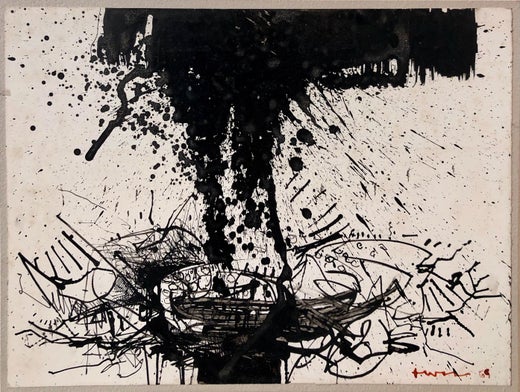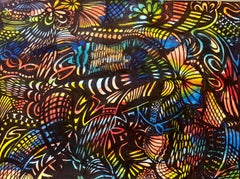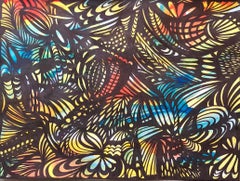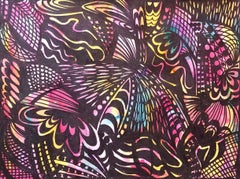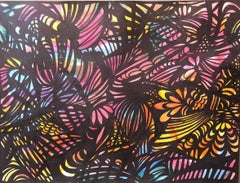Want more images or videos?
Request additional images or videos from the seller
1 of 15
John LeveeAbstract Expressionist Drawing1969
1969
$5,500List Price
About the Item
- Creator:John Levee (1924 - 2017, American, French)
- Creation Year:1969
- Dimensions:Height: 12 in (30.48 cm)Width: 17 in (43.18 cm)
- Medium:
- Movement & Style:
- Period:
- Condition:good. mounted to original backing.
- Gallery Location:Surfside, FL
- Reference Number:1stDibs: LU3827512082
John Levee
John Harrison Levée was one of the leading American artists in Paris during the post-war period along with Sam Francis and Paul Jenkins. A prominent exponent of Abstract Expressionism or Abstraction Lyrique, as it was known in France, Levée established an international reputation with numerous museum exhibitions. These works are outstanding examples of the artist’s powerful style which uniquely combines both the American and European inspirations for this epoch-defining Modernist movement. Having been born in California, Levée attended the Institute of Art there with fellow students Mark Rothko, Clyfford Still and Richard Diebenkorn, before finding himself in the Second World War fighting to liberate France in 1944. Following which he went to New York to continue at art school with Stuart Davis and Abbe Rattner, and then obtained a grant to study in Paris on the G.I. Bill. He arrived back in Paris in 1949 and enrolled at the avant-garde Academie Julian in 1950 where he met fellow American artist Sam Francis. In 1951 he held his first solo exhibition at Galerie 8, and also began exhibiting at the Salon d’Automne, the Salon de Mai and the Salon des Réalités Nouvelles. Numerous exhibitions ensued including “Peintres les Americains en France” Galerie Craven in 1953, “Dix Jeunes Peintres de l’Ecole de Paris” Galerie de France in 1956, “Antagonismes” Musée des Arts Décoratifs in 1960, and the famous annual “L’Ecole de Paris” exhibitions at Galerie Charpentier from 1958-1961. His early painting was inspired by the New York School of Abstract Expressionism, which included Franz Kline, Robert Motherwell, Jackson Pollock, Mark Rothko, Ad Reinhardt, Willem de Kooning and Philip Guston, among others. After a period of hard-edge painting based on geometric abstraction in the 1960s, Levee returned to his more spontaneous Abstract Expressionism style, often using collage elements with loose brush work typical of lyrical abstraction. Levée also quickly established an international reputation, exhibiting at the Museum of Modern Art in New York in 1957 and 1958, the Whitney Museum NY in 1957, 1959 and 1965, Carnegie Institute 1958, Museum of Modern Art Jerusalem 1963, Phoenix Museum of Art Arizona 1964, Museum of Tel Aviv 1969, Palm Springs Museum 1977. Throughout this period he also held regular exhibitions at the New York art dealer Andre Emmerich and in London at Gimpel Fils. A major retrospective of the artist’s work was held at the Musée d’Art Moderne in Toulouse in 1983.
About the Seller
4.9
Platinum Seller
Premium sellers with a 4.7+ rating and 24-hour response times
Established in 1995
1stDibs seller since 2014
1,846 sales on 1stDibs
Typical response time: 1 hour
Authenticity Guarantee
In the unlikely event there’s an issue with an item’s authenticity, contact us within 1 year for a full refund. DetailsMoney-Back Guarantee
If your item is not as described, is damaged in transit, or does not arrive, contact us within 7 days for a full refund. Details24-Hour Cancellation
You have a 24-hour grace period in which to reconsider your purchase, with no questions asked.Vetted Professional Sellers
Our world-class sellers must adhere to strict standards for service and quality, maintaining the integrity of our listings.Price-Match Guarantee
If you find that a seller listed the same item for a lower price elsewhere, we’ll match it.Trusted Global Delivery
Our best-in-class carrier network provides specialized shipping options worldwide, including custom delivery.You May Also Like
Ron Gorchov Mid Century Modern Abstract Expressionist painting on paper Signed
By Ron Gorchov
Located in New York, NY
Ron Gorchov
Untitled early 1960s Abstract Expressionist work, 1962
Ink and watercolor painting on paper
Signed and dated in black ink lower left recto
Frame included:
elegantly floa...
Category
1960s Abstract Expressionist Abstract Drawings and Watercolors
Materials
Ink, Watercolor
$15,000
H 16.25 in W 13.5 in D 1 in
Non-Objective abstract work on paper by well-known San Francisco Bay Area artist
By Erle Loran
Located in Colfax, CA
A great, and early, non-objective ab-ex study by Erle Loran, most likely created in the 1940s,
Erle Loran, (1905-1999), was an American painter and educator who painted for the enti...
Category
1940s Abstract Expressionist Abstract Drawings and Watercolors
Materials
Ink
$950
H 18 in W 15.5 in D 1 in
The garden of delights - abstraction art, made in pink, purple, grey color
By Mila Akopova
Located in Fort Lee, NJ
Interior design paintings. The diptych is made with alcoholic ink in pink, purple, fuchsia, grey color on Yupo paper.
Each work is 11 by 14 inches in size, framed (black) with a styr...
Category
2010s Abstract Expressionist Abstract Paintings
Materials
Paper, Ink
Abstract with Cats, Original Signed Contemporary Abstract Expressionist Work
Located in Boston, MA
Abstract with Cats, Original Contemporary Abstract Expressionist Work, 2019
8" x 10" (HxW) Ink and Watercolor on Paper
Hand-signed by the artist.
An abstract expressionist work fill...
Category
21st Century and Contemporary Abstract Expressionist Abstract Drawings a...
Materials
Paper, Ink, Watercolor
$400
H 8 in W 10 in D 0.1 in
Information Superhighway, Original Contemporary Abstract Expressionist Drawing
Located in Boston, MA
Information Superhighway, Original Contemporary Abstract Expressionist Drawing
16" x 20" Ink with Silverpoint, Paint, and Metal Foil on Paper Panel
This highly geometric abstract ex...
Category
21st Century and Contemporary Abstract Expressionist Abstract Drawings a...
Materials
Foil
$975
H 16 in W 20 in D 0.1 in
Black and White
By Arthur Pinajian
Located in La Canada Flintridge, CA
The artist Pinajian signed lower right with ink. it is ink on paper.
Category
1950s Abstract Expressionist Abstract Drawings and Watercolors
Materials
Archival Ink
Abstract Expressionist British Original Watercolor Painting Shapes Patterns
By Robert Somerton
Located in Cirencester, Gloucestershire
Abstract Composition (c.2022)
by Robert Somerton, British, born 1972.
dated 18
ink/ watercolor on art paper, unframed
size: 9.5 x 12.5 inches
condition: excellent
Category
2010s Abstract Expressionist Abstract Paintings
Materials
Ink, Watercolor
$1,295
H 9.5 in W 12.5 in D 0.1 in
Abstract Expressionist British Original Watercolor Painting Shapes Patterns
By Robert Somerton
Located in Cirencester, Gloucestershire
Abstract Composition (c.2022)
by Robert Somerton, British, born 1972.
ink/ watercolor on art paper, unframed
size: 9.5 x 12.5 inches
condition: excellent
Category
2010s Abstract Expressionist Abstract Paintings
Materials
Ink, Watercolor
$1,295
H 9.5 in W 12.5 in D 0.1 in
Abstract Expressionist British Original Watercolor Painting Shapes Patterns
By Robert Somerton
Located in Cirencester, Gloucestershire
Abstract Composition (c.2022)
by Robert Somerton, British, born 1972.
dated 18
ink/ watercolor on art paper, unframed
size: 9.5 x 12.5 inches
condition: excellent
Category
2010s Abstract Expressionist Abstract Paintings
Materials
Ink, Watercolor
$1,295
H 9.5 in W 12.5 in D 0.1 in
Abstract Expressionist British Original Watercolor Painting Shapes Patterns
By Robert Somerton
Located in Cirencester, Gloucestershire
Abstract Composition (c.2022)
by Robert Somerton, British, born 1972.
ink/ watercolor on art paper, unframed
size: 9.5 x 12.5 inches
condition: excellent
Category
2010s Abstract Expressionist Abstract Paintings
Materials
Ink, Watercolor
$1,295
H 9.5 in W 12.5 in D 0.1 in
More From This Seller
View AllVeiled Series L, Abstract Expressionist Organic Drawing Watercolor Painting
By Dorothy Gillespie
Located in Surfside, FL
Dorothy Gillespie (June 29, 1920 – September 30, 2012) was an American artist and sculptor who became known for her large and colorful abstract metal sculptures. Gillespie became best known for the aluminum sculptures she started to produce at the end of the 1970s. She would paint sheets of the metal, cut them into strips and connect the strips together to resemble cascades or starbursts of bright colored ribbon. The New York Times once summarized her work as “topsy-turvy, merrymaking fantasy,” and in another review declared, “The artist’s exuberant sculptures of colorful aluminum strips have earned her an international reputation.Her works are featured at her alma mater (Radford University) in Virginia, where she later returned to teach, as well as in New York (where she was artist in residence for the feminist Women's Interart Center), Wilmington, North Carolina and Florida.
She enrolled both at Radford University near her hometown, and the Maryland Institute College of Art in Baltimore, Maryland. The director of the Maryland Institute, Hans Schuler, helped foster her career in fine art.
On June 5, 1943, aged 23, Gillespie moved to New York City. There she took a job at the B. Altman department store as assistant art director. She also joined the Art Students League where she was exposed to new ideas about techniques, materials, and marketing. She also created works at Atelier 17 printmaking studio, where Stanley William Hayter encouraged to experiment with her own ideas.
She and her husband, Bernard Israel, opened a restaurant and night club in Greenwich Village to support their family. She returned to making art in 1957, and worked at art full-time after they sold the nightclub in the 1970.
In 1977 Gillespie gave her first lecture series at the New School for Social Research, and she would give others there until 1982. She taught at her alma mater as a Visiting Artist (1981-1983) and gave Radford University some of her work to begin its permanent art collection. Gillespie then served as Woodrow Wilson visiting Fellow (1985-1994), visiting many small private colleges to give public lectures and teach young artists. She returned to Radnor University to teach as Distinguished Professor of Art (1997–99).[8] She also hosted a radio program, the Dorothy Gillespie Show on Radio Station WHBI in New York from 1967-1973.
Gillespie began moving away from realism and into the abstraction that marked her career. Gillespie returned to New York City in 1963 to continue her career. She maintained a studio through the 70s and advocate worked towards feminist goals in the art industry, picketing the Whitney Museum, helping to organize the Women's Interart Center, curating exhibitions of women's art, and writing articles raising awareness of her cause. Gillespie numbered among her acquaintances such art-world luminaries as Jackson Pollock, Lee Krasner, Alice Neel, Louise Nevelson and Georgia O’Keeffe. “She had amazing stories that unfortunately are gone,” her son said.
During the 1960s, she built multimedia art installations that made political statements, such as 1965’s “Made in the USA,” that used blinking colored lights, mirrors, shadow boxes, rotating figures and tape recordings to convey a chaotic look at American commercial fads. The floor was strewn with real dollar bills, which visitors assumed were fake.
By the 1980s, Gillespie's work had come to be known internationally. She completed many commissions for sculptures in public places, including Lincoln Center, Rockefeller Center and Walt Disney World Epcot Center in Orlando, Florida. Her work is in many collections across the United States, including the Delaware Museum, the Solomon R. Guggenheim Museum, and the National Museum of Women in the Arts. Her sculptures can also be found in the Frankfurt Museum in Germany and the Tel Aviv Museum in Israel.
Group Shows Conceived and Curated by Dorothy Gillespie
Women's Interart Center, New York, NY 1974 included: Betty Parsons, Elsie Asher, Alice Baber, Minna Citron, Nancy Spero, Seena Donneson, Alice Neel, Natalie Edgar, Dorothy Gillespie, and Anita Steckel...
Category
Early 2000s Abstract Expressionist Abstract Drawings and Watercolors
Materials
Paper, Ink, Watercolor, Permanent Marker
Veiled Series X , Abstract Expressionist Organic Drawing Watercolor Painting
By Dorothy Gillespie
Located in Surfside, FL
Dorothy Gillespie (June 29, 1920 – September 30, 2012) was an American artist and sculptor who became known for her large and colorful abstract metal sculptures. Gillespie became best known for the aluminum sculptures she started to produce at the end of the 1970s. She would paint sheets of the metal, cut them into strips and connect the strips together to resemble cascades or starbursts of bright colored ribbon. The New York Times once summarized her work as “topsy-turvy, merrymaking fantasy,” and in another review declared, “The artist’s exuberant sculptures of colorful aluminum strips have earned her an international reputation.Her works are featured at her alma mater (Radford University) in Virginia, where she later returned to teach, as well as in New York (where she was artist in residence for the feminist Women's Interart Center), Wilmington, North Carolina and Florida.
She enrolled both at Radford University near her hometown, and the Maryland Institute College of Art in Baltimore, Maryland. The director of the Maryland Institute, Hans Schuler, helped foster her career in fine art.
On June 5, 1943, aged 23, Gillespie moved to New York City. There she took a job at the B. Altman department store as assistant art director. She also joined the Art Students League where she was exposed to new ideas about techniques, materials, and marketing. She also created works at Atelier 17 printmaking studio, where Stanley William Hayter encouraged to experiment with her own ideas.
She and her husband, Bernard Israel, opened a restaurant and night club in Greenwich Village to support their family. She returned to making art in 1957, and worked at art full-time after they sold the nightclub in the 1970.
In 1977 Gillespie gave her first lecture series at the New School for Social Research, and she would give others there until 1982. She taught at her alma mater as a Visiting Artist (1981-1983) and gave Radford University some of her work to begin its permanent art collection. Gillespie then served as Woodrow Wilson visiting Fellow (1985-1994), visiting many small private colleges to give public lectures and teach young artists. She returned to Radnor University to teach as Distinguished Professor of Art (1997–99).[8] She also hosted a radio program, the Dorothy Gillespie Show on Radio Station WHBI in New York from 1967-1973.
Gillespie began moving away from realism and into the abstraction that marked her career. Gillespie returned to New York City in 1963 to continue her career. She maintained a studio through the 70s and advocate worked towards feminist goals in the art industry, picketing the Whitney Museum, helping to organize the Women's Interart Center, curating exhibitions of women's art, and writing articles raising awareness of her cause. Gillespie numbered among her acquaintances such art-world luminaries as Jackson Pollock, Lee Krasner, Alice Neel, Louise Nevelson and Georgia O’Keeffe. “She had amazing stories that unfortunately are gone,” her son said.
During the 1960s, she built multimedia art installations that made political statements, such as 1965’s “Made in the USA,” that used blinking colored lights, mirrors, shadow boxes, rotating figures and tape recordings to convey a chaotic look at American commercial fads. The floor was strewn with real dollar bills, which visitors assumed were fake.
By the 1980s, Gillespie's work had come to be known internationally. She completed many commissions for sculptures in public places, including Lincoln Center, Rockefeller Center and Walt Disney World Epcot Center in Orlando, Florida. Her work is in many collections across the United States, including the Delaware Museum, the Solomon R. Guggenheim Museum, and the National Museum of Women in the Arts. Her sculptures can also be found in the Frankfurt Museum in Germany and the Tel Aviv Museum in Israel.
Group Shows Conceived and Curated by Dorothy Gillespie
Women's Interart Center, New York, NY 1974 included: Betty Parsons, Elsie Asher, Alice Baber, Minna Citron, Nancy Spero, Seena Donneson, Alice Neel, Natalie Edgar, Dorothy Gillespie, and Anita Steckel...
Category
Early 2000s Abstract Expressionist Abstract Drawings and Watercolors
Materials
Paper, Ink, Watercolor, Permanent Marker
Veiled Series LX , Abstract Expressionist Organic Drawing Watercolor Painting
By Dorothy Gillespie
Located in Surfside, FL
Dorothy Gillespie (June 29, 1920 – September 30, 2012) was an American artist and sculptor who became known for her large and colorful abstract metal sculptures. Gillespie became best known for the aluminum sculptures she started to produce at the end of the 1970s. She would paint sheets of the metal, cut them into strips and connect the strips together to resemble cascades or starbursts of bright colored ribbon. The New York Times once summarized her work as “topsy-turvy, merrymaking fantasy,” and in another review declared, “The artist’s exuberant sculptures of colorful aluminum strips have earned her an international reputation.Her works are featured at her alma mater (Radford University) in Virginia, where she later returned to teach, as well as in New York (where she was artist in residence for the feminist Women's Interart Center), Wilmington, North Carolina and Florida.
She enrolled both at Radford University near her hometown, and the Maryland Institute College of Art in Baltimore, Maryland. The director of the Maryland Institute, Hans Schuler, helped foster her career in fine art.
On June 5, 1943, aged 23, Gillespie moved to New York City. There she took a job at the B. Altman department store as assistant art director. She also joined the Art Students League where she was exposed to new ideas about techniques, materials, and marketing. She also created works at Atelier 17 printmaking studio, where Stanley William Hayter encouraged to experiment with her own ideas.
She and her husband, Bernard Israel, opened a restaurant and night club in Greenwich Village to support their family. She returned to making art in 1957, and worked at art full-time after they sold the nightclub in the 1970.
In 1977 Gillespie gave her first lecture series at the New School for Social Research, and she would give others there until 1982. She taught at her alma mater as a Visiting Artist (1981-1983) and gave Radford University some of her work to begin its permanent art collection. Gillespie then served as Woodrow Wilson visiting Fellow (1985-1994), visiting many small private colleges to give public lectures and teach young artists. She returned to Radnor University to teach as Distinguished Professor of Art (1997–99).[8] She also hosted a radio program, the Dorothy Gillespie Show on Radio Station WHBI in New York from 1967-1973.
Gillespie began moving away from realism and into the abstraction that marked her career. Gillespie returned to New York City in 1963 to continue her career. She maintained a studio through the 70s and advocate worked towards feminist goals in the art industry, picketing the Whitney Museum, helping to organize the Women's Interart Center, curating exhibitions of women's art, and writing articles raising awareness of her cause. Gillespie numbered among her acquaintances such art-world luminaries as Jackson Pollock, Lee Krasner, Alice Neel, Louise Nevelson and Georgia O’Keeffe. “She had amazing stories that unfortunately are gone,” her son said.
During the 1960s, she built multimedia art installations that made political statements, such as 1965’s “Made in the USA,” that used blinking colored lights, mirrors, shadow boxes, rotating figures and tape recordings to convey a chaotic look at American commercial fads. The floor was strewn with real dollar bills, which visitors assumed were fake.
By the 1980s, Gillespie's work had come to be known internationally. She completed many commissions for sculptures in public places, including Lincoln Center, Rockefeller Center and Walt Disney World Epcot Center in Orlando, Florida. Her work is in many collections across the United States, including the Delaware Museum, the Solomon R. Guggenheim Museum, and the National Museum of Women in the Arts. Her sculptures can also be found in the Frankfurt Museum in Germany and the Tel Aviv Museum in Israel.
Group Shows Conceived and Curated by Dorothy Gillespie
Women's Interart Center, New York, NY 1974 included: Betty Parsons, Elsie Asher, Alice Baber, Minna Citron, Nancy Spero, Seena Donneson, Alice Neel, Natalie Edgar, Dorothy Gillespie, and Anita Steckel...
Category
Early 2000s Abstract Expressionist Abstract Drawings and Watercolors
Materials
Paper, Ink, Watercolor, Permanent Marker
Veiled Series XXX, Abstract Expressionist Organic Drawing Watercolor Painting
By Dorothy Gillespie
Located in Surfside, FL
Dorothy Gillespie (June 29, 1920 – September 30, 2012) was an American artist and sculptor who became known for her large and colorful abstract metal sculptures. Gillespie became best known for the aluminum sculptures she started to produce at the end of the 1970s. She would paint sheets of the metal, cut them into strips and connect the strips together to resemble cascades or starbursts of bright colored ribbon. The New York Times once summarized her work as “topsy-turvy, merrymaking fantasy,” and in another review declared, “The artist’s exuberant sculptures of colorful aluminum strips have earned her an international reputation.Her works are featured at her alma mater (Radford University) in Virginia, where she later returned to teach, as well as in New York (where she was artist in residence for the feminist Women's Interart Center), Wilmington, North Carolina and Florida.
She enrolled both at Radford University near her hometown, and the Maryland Institute College of Art in Baltimore, Maryland. The director of the Maryland Institute, Hans Schuler, helped foster her career in fine art.
On June 5, 1943, aged 23, Gillespie moved to New York City. There she took a job at the B. Altman department store as assistant art director. She also joined the Art Students League where she was exposed to new ideas about techniques, materials, and marketing. She also created works at Atelier 17 printmaking studio, where Stanley William Hayter encouraged to experiment with her own ideas.
She and her husband, Bernard Israel, opened a restaurant and night club in Greenwich Village to support their family. She returned to making art in 1957, and worked at art full-time after they sold the nightclub in the 1970.
In 1977 Gillespie gave her first lecture series at the New School for Social Research, and she would give others there until 1982. She taught at her alma mater as a Visiting Artist (1981-1983) and gave Radford University some of her work to begin its permanent art collection. Gillespie then served as Woodrow Wilson visiting Fellow (1985-1994), visiting many small private colleges to give public lectures and teach young artists. She returned to Radnor University to teach as Distinguished Professor of Art (1997–99).[8] She also hosted a radio program, the Dorothy Gillespie Show on Radio Station WHBI in New York from 1967-1973.
Gillespie began moving away from realism and into the abstraction that marked her career. Gillespie returned to New York City in 1963 to continue her career. She maintained a studio through the 70s and advocate worked towards feminist goals in the art industry, picketing the Whitney Museum, helping to organize the Women's Interart Center, curating exhibitions of women's art, and writing articles raising awareness of her cause. Gillespie numbered among her acquaintances such art-world luminaries as Jackson Pollock, Lee Krasner, Alice Neel, Louise Nevelson and Georgia O’Keeffe. “She had amazing stories that unfortunately are gone,” her son said.
During the 1960s, she built multimedia art installations that made political statements, such as 1965’s “Made in the USA,” that used blinking colored lights, mirrors, shadow boxes, rotating figures and tape recordings to convey a chaotic look at American commercial fads. The floor was strewn with real dollar bills, which visitors assumed were fake.
By the 1980s, Gillespie's work had come to be known internationally. She completed many commissions for sculptures in public places, including Lincoln Center, Rockefeller Center and Walt Disney World Epcot Center in Orlando, Florida. Her work is in many collections across the United States, including the Delaware Museum, the Solomon R. Guggenheim Museum, and the National Museum of Women in the Arts. Her sculptures can also be found in the Frankfurt Museum in Germany and the Tel Aviv Museum in Israel.
Group Shows Conceived and Curated by Dorothy Gillespie
Women's Interart Center, New York, NY 1974 included: Betty Parsons, Elsie Asher, Alice Baber, Minna Citron, Nancy Spero, Seena Donneson, Alice Neel, Natalie Edgar, Dorothy Gillespie, and Anita Steckel...
Category
Early 2000s Abstract Expressionist Abstract Drawings and Watercolors
Materials
Paper, Ink, Watercolor, Permanent Marker
Veiled Series XX , Abstract Expressionist Organic Drawing Watercolor Painting
By Dorothy Gillespie
Located in Surfside, FL
Dorothy Gillespie (June 29, 1920 – September 30, 2012) was an American artist and sculptor who became known for her large and colorful abstract metal sculptures. Gillespie became best known for the aluminum sculptures she started to produce at the end of the 1970s. She would paint sheets of the metal, cut them into strips and connect the strips together to resemble cascades or starbursts of bright colored ribbon. The New York Times once summarized her work as “topsy-turvy, merrymaking fantasy,” and in another review declared, “The artist’s exuberant sculptures of colorful aluminum strips have earned her an international reputation.Her works are featured at her alma mater (Radford University) in Virginia, where she later returned to teach, as well as in New York (where she was artist in residence for the feminist Women's Interart Center), Wilmington, North Carolina and Florida.
She enrolled both at Radford University near her hometown, and the Maryland Institute College of Art in Baltimore, Maryland. The director of the Maryland Institute, Hans Schuler, helped foster her career in fine art.
On June 5, 1943, aged 23, Gillespie moved to New York City. There she took a job at the B. Altman department store as assistant art director. She also joined the Art Students League where she was exposed to new ideas about techniques, materials, and marketing. She also created works at Atelier 17 printmaking studio, where Stanley William Hayter encouraged to experiment with her own ideas.
She and her husband, Bernard Israel, opened a restaurant and night club in Greenwich Village to support their family. She returned to making art in 1957, and worked at art full-time after they sold the nightclub in the 1970.
In 1977 Gillespie gave her first lecture series at the New School for Social Research, and she would give others there until 1982. She taught at her alma mater as a Visiting Artist (1981-1983) and gave Radford University some of her work to begin its permanent art collection. Gillespie then served as Woodrow Wilson visiting Fellow (1985-1994), visiting many small private colleges to give public lectures and teach young artists. She returned to Radnor University to teach as Distinguished Professor of Art (1997–99).[8] She also hosted a radio program, the Dorothy Gillespie Show on Radio Station WHBI in New York from 1967-1973.
Gillespie began moving away from realism and into the abstraction that marked her career. Gillespie returned to New York City in 1963 to continue her career. She maintained a studio through the 70s and advocate worked towards feminist goals in the art industry, picketing the Whitney Museum, helping to organize the Women's Interart Center, curating exhibitions of women's art, and writing articles raising awareness of her cause. Gillespie numbered among her acquaintances such art-world luminaries as Jackson Pollock, Lee Krasner, Alice Neel, Louise Nevelson and Georgia O’Keeffe. “She had amazing stories that unfortunately are gone,” her son said.
During the 1960s, she built multimedia art installations that made political statements, such as 1965’s “Made in the USA,” that used blinking colored lights, mirrors, shadow boxes, rotating figures and tape recordings to convey a chaotic look at American commercial fads. The floor was strewn with real dollar bills, which visitors assumed were fake.
By the 1980s, Gillespie's work had come to be known internationally. She completed many commissions for sculptures in public places, including Lincoln Center, Rockefeller Center and Walt Disney World Epcot Center in Orlando, Florida. Her work is in many collections across the United States, including the Delaware Museum, the Solomon R. Guggenheim Museum, and the National Museum of Women in the Arts. Her sculptures can also be found in the Frankfurt Museum in Germany and the Tel Aviv Museum in Israel.
Group Shows Conceived and Curated by Dorothy Gillespie
Women's Interart Center, New York, NY 1974 included: Betty Parsons, Elsie Asher, Alice Baber, Minna Citron, Nancy Spero, Seena Donneson, Alice Neel, Natalie Edgar, Dorothy Gillespie, and Anita Steckel...
Category
Early 2000s Abstract Expressionist Abstract Drawings and Watercolors
Materials
Paper, Ink, Watercolor, Permanent Marker
Abstract Expressionist Drawing
By John Levee
Located in Surfside, FL
Provenance: Darthea Speyer, Paris.
backing 12 X 17 image 8.5 X 11.5
John Levee (1924 - 2017) was an American modern art abstract expressionist painter who had worked in Paris since ...
Category
1960s Abstract Expressionist Abstract Drawings and Watercolors
Materials
Ink
Still Thinking About These?
All Recently ViewedMore Ways To Browse
John Levee
Artist Signatures
Signed Plate
Antique Lithograph Prints
Vintage Attends
Slim Aarons Prints
Framed Acrylic Painting
French Oil Paintings With Frame
Oil Paintings New York City
Used Plexiglass
Antique Original Prints
Black And White Framed Photographs
Artist Proof
Used Tvs
Woman Art
Antique Print Etching
Surrealist Vintage
Abstract Black And White Paintings
